Abstract
A flood forecasting and early warning system is critical for rivers that have a large flood potential, one of which is the Gilireng watershed, which floods every year and causes many losses in Wajo Regency, Indonesia. This research also introduces an integration model between UH SUH and HEC-RAS in flood impact analysis, as a reference for flood forecasting and early warning systems in anticipating the timing and occurrence of floods, as well as GIS in the spatial modeling of flood-prone areas. Broadly speaking, this research is divided into four stages, namely, a flood hydrological analysis using UH SUH, flood hydraulic tracing using a 2D HEC-RAS numerical model, the spatial modeling of flood-prone areas using GIS, and the preparation of flood forecasting and early warning systems. The results of the analysis of the flood forecasting and early warning systems obtained the flood travel time and critical time at the observation point, the total time required from the upstream observation point to level 3 at Gilireng Dam for 1 h 35 min, Mamminasae Bridge for 4 h 35 min, and Akkotengeng Bridge for 8 h 40 min. This is enough time for people living in flood-prone areas to evacuate to the 15 recommended evacuation centers.
1. Introduction
Indonesia is an archipelago with many rivers that require integrated water resources management [1,2]. Such management is expected to reduce the destructive power of water in the community. One of the destructive forces of water is flooding [3,4].
Flooding is a natural phenomenon that cannot be prevented, but can be mitigated [5,6]. Flood events are the result of various causes, such as climate change and extreme rainfall, coupled with watershed conditions that are unable to retain rainwater, causing large surface runoff [7,8]. If the river is unable to accommodate the runoff flow, a large flood can occur [9,10].
Although flooding cannot be prevented, it can be attempted to be controlled in order to minimize the negative impacts of flood disasters through flood impact analysis studies. The subsequent flood tracing can be used as a reference in the planning of flood forecasting and early warning systems [11,12].
To improve the flood forecasting and early warning system (FFEWS), it is necessary to change the old paradigm, which was limited to forecasting flood hazards due to the intensity of rainfall, to a new paradigm, namely, forecasting the impact on areas that will become a threat in the event of extreme rainfall intensity [13]. The new paradigm goes one step further by directly analyzing the affected areas and providing the best solution in the event of a flood [14,15].
Specifically for flood forecasting and early warning, the aim is to know and predict the length of time a flood will occur sometime before the flood comes. This allows residents in flood-prone areas to save themselves from flooding by carrying away salvageable items, to reduce losses due to flooding. So this flood forecasting and early warning system is very supportive in handling and evacuating residents in flood-prone areas [16,17].
In large-scale flood forecasting and warning systems, hydrological models are one of the important components in determining the watershed response to rain or the conversion of rain into discharge [18,19,20]. One of the most popular hydrological models in converting rainfall into discharge, especially for areas that do not have measuring instruments, is the Synthetic Unit Hydrograph method, which is able to estimate discharge and flood duration simultaneously [21,22]. The Synthetic Unit Hydrograph (SUH) that is to be introduced in this study is the UH SUH, which is the latest hydrograph model developed at Hasanuddin University (UH) in 2024 based on the selection of 19 morphometric characteristics of the watershed, including 3 characteristics that never existed in the previous SUH, namely, circularity ratio, watershed texture, and length of overland flow. UH SUH has been tested for reliability in several watersheds in South Sulawesi, Indonesia, with a Nash–Sutcliffe Efficiency (NSE) value = 0.90, which means that the hydrological model is very accurate, with the average deviation of parameters (peak discharge, peak time, and base time) <10% [23]. The output of this hydrological model is a time series of flow rates in the river.
In the preparation of a flood forecasting and warning system based on impact forecasting, hydrological models must be combined with hydraulic models for flood impact analysis [24]. Following the latest advances in science and technology, currently, hydraulic models in the form of numerical modeling have been developed and can be applied to flood impact analysis simulations to predict flood distribution, water level, flow velocity, and flood arrival time. The existence of numerical modeling is also an advantage to overcome the limitations of physical models, limitations of direct observation, and data limitations [25,26]. One good software in the numerical modeling of natural and structural channel systems is the HEC-RAS application [27].
In addition to hydrological models and hydraulic models, the use of geographic information systems (GISs) has significantly improved numerical flood modeling [28]. A GIS is a spatial information system that can extract the morphometric characteristics of a watershed from a digital elevation model (DEM) as input material for hydrological models. In addition, a GIS can also be applied in analyzing the flood potential of HEC-RAS simulation results [29]. Therefore, the integration of hydrological models, numerical models, and GIS is very important in predicting flood events and evaluating flood control strategies.
Research related to the integration of hydrological models, hydraulics models, and GIS has been conducted, such as Peker et al., integrating HEC-RAS and HEC-HMS with GIS in flood modeling and flood hazard mapping in the Goksu watershed in Turkey [28]. Yerramilli integrated HEC-RAS and GIS in identifying and assessing flood risk vulnerability in Jackson City, USA [30]. Azimah et al. integrated HEC-RAS and GIS in the development of a flood evacuation center along the Sembrong River in Malaysia [31]. Khaghan and Mojaradi integrated HEC-RAS and GIS to simulate flooding in Karaj City, Iran [32]. Aminah et al. integrated GIS and HEC-RAS for flood modeling in the Martil River, Northern Morocco [33].
Although several studies on the integration of hydrological models, hydraulics models, and GIS have been conducted in several countries, no similar studies have been conducted on the preparation of flood forecasting and early warning systems. The novelty of this research is the introduction of UH SUH in hydrological modeling, which is then integrated with HEC-RAS and GIS to prepare flood forecasting and early warning systems.
This flood forecasting and early warning system is essential for rivers that have a large flood potential, such as the Gilireng watershed, which floods every year and causes many losses in Wajo Regency, South Sulawesi Province, Indonesia. This research is interesting, so as to see the extent of the ability of the Gilireng River to accommodate the reduced flood discharge from the newly functioning Passeloreng reservoir, based on the rainfall trend data that occurs. This research also introduces the integration model between UH SUH and HEC-RAS in flood impact analysis as a reference for flood forecasting and early warning systems, in anticipating the timing and occurrence of floods, as well as a GIS in the spatial modeling of flood-prone areas.
2. Materials and Methods
This study was conducted in the Gilireng watershed, South Sulawesi Province, Indonesia. Administratively, the Gilireng watershed is included in 2 regions, namely Sidrap Regency in the upper reaches of the river and Wajo Regency in the middle and upper reaches of the river. However, the flood impact analysis is only carried out in the middle stream (Gilireng Dam) towards the downstream, which is an area that is almost annually affected by floods along ±46.45 km, which is geographically located at 3°55′2.41″ S and 120°11′4.66″ E to 3°58′54.67″ S and 120°21′6.77″ E. The research location can be seen in Figure 1.
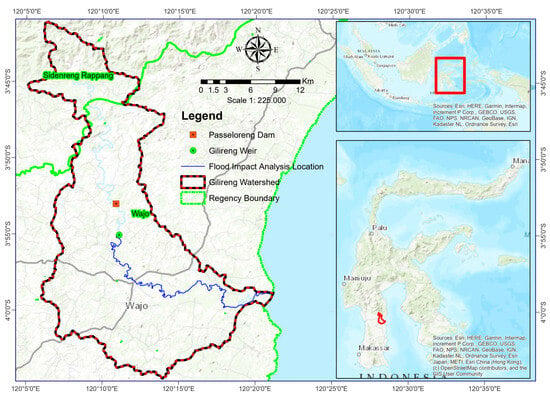
Figure 1.
Research location.
The research was conducted by collecting data from the Pompengan Jeneberang River Basin Center (BBWS-PJ), the Geospatial Information Agency (BIG), and relevant data published on the website. The data collected from the Pompengan Jeneberang River Basin Center are the last 10 years of rainfall data, namely, 2023–2014, to see the rainfall pattern. Furthermore, the data for flood hydraulic tracing uses measurement data of river topography data along ±46.45 km, combined with 2.7 ArcSecond (8.4 m) resolution DEMNAS from the Geospatial Information Agency (BIG) [34]. Broadly speaking, this research is divided into 4 stages: The first stage is flood hydrology analysis using UH SUH. The second stage is flood hydraulic tracing using a 2D HEC-RAS numerical model. The third stage is the spatial modeling of flood-prone areas using a GIS. The fourth stage is the flood forecasting and early warning system.
2.1. Flood Hydrology Analysis UH SUH Method
This analysis uses data taken from related agencies in the form of daily rainfall data and topographic data from the National Digital Elevation Model (DEMNAS). The data will be analyzed to obtain the flood discharge. The hydrological analysis here also indirectly interprets the influence of rainfall intensity, relief/topography, soil infiltration, and land use [35,36].
In this analysis, the calculation of flood discharge refers to the trend of the last 10 years of rainfall intensity falling in the Gilireng watershed. The classification of rain intensity based on the Meteorology and Climatology Geophysics Agency (BMKG) is divided into 5 classes, namely light rain (5–20 mm/day), moderate rain (20–50 mm/day), heavy rain (50–100 mm/day), very heavy rain (100–150 mm/day), and extreme rain (>150 mm/day) [37,38].
After the selection of rainfall intensity based on the trend of rainfall data is obtained, the next step is the conversion of rainfall into discharge using the Synthetic Unit Hydrograph (SUH) method, considering that this method is very suitable to be applied to the Gilireng watershed which does not have a water level measuring instrument or river discharge. The Synthetic Unit Hydrograph method is able to estimate discharge and flood duration simultaneously [39,40]. The preparation of Synthetic Unit Hydrographs (SUHs) uses a set of empirical equations, namely, the relationship between physical characteristics and elements of hydrograph formation such as peak discharge (Qp), peak time (Tp), and base time (Tb) [41,42]. Thus, the SUH method will provide fairly accurate results when used in the area where the SUH method was developed [43,44]. Considering that UH SUH is one of the hydrological models developed based on the morphometric characteristics of watersheds in Indonesia, especially South Sulawesi, then in this study the hydrological analysis uses UH SUH. The following is the equation used in UH SUH:
where Tp = peak time (h), Tb = base time (h), Qp = peak discharge (m3/s/mm), q(t) = hydrograph curve equation, L = length of main river (km), A = watershed area (km2), Rc = circularity ratio, P = perimeter (km), SN = source frequency, RUA = upstream watershed area factor, P1 = number of level 1 river segments, PN = number of river segments of all levels, Au = upstream watershed area (km2), R = rainfall (mm), ASUH = area of dimensionless unit hydrograph curves performed numerically with the trapezoidal method, Ai = area of plane of dimensionless curve, T = time (hour), and C = hydrograph coefficient positive number 1, 2, 3,…… and so on (if there are no calibration data, C = 2).
In addition, the flood discharge analysis obtained is influenced by the reduction of the Passeloreng reservoir, so it is necessary to conduct a flood tracing to determine the amount of flood reduction from the Passeloreng reservoir/dam with a free sill side spillway type, using the Level Pool Reservoir method. The flood discharge analysis process can be seen in Figure 2.
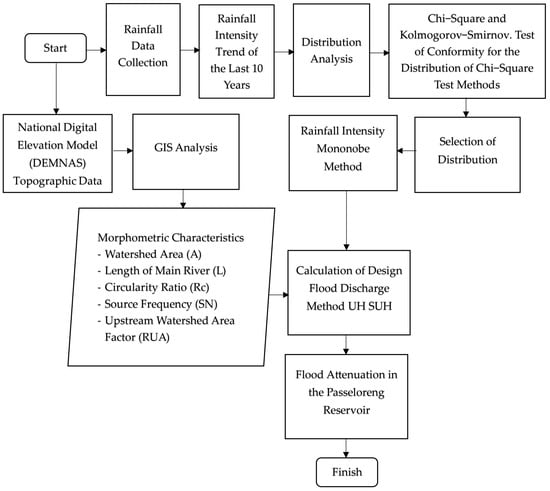
Figure 2.
Flood discharge analysis process.
2.2. Flood Hydraulic Tracing Using 2D HEC-RAS Numerical Modeling
The HEC-RAS 2D unsteady flow numerical model combines the mass conservation or continuity equation with the diffusion wave equation to calculate the water surface elevation at a point in time [45,46]. In the HEC-RAS application, there are two equations that can be used, namely, full Saint-Venant/full momentum and diffusion wave. Given the coverage of a large simulation area, the equation used is diffusion wave, so that the simulation runs stably [47].
In a 2D HEC-RAS numerical simulation, there are 3 components that need to be included in the RAS Mapper (GIS-based HEC-RAS tool): terrain, geometry, and land cover layer. The terrain component is useful for modeling the study field/topography. The input in the terrain component is the National Digital Elevation Model (DEMNAS). To increase the accuracy of the simulation, DEMNAS is combined with river topo-bathymetric measurements, because the DEMNAS resolution is not yet able to display the actual river cross-section. The process of preparing the terrain model in the HEC-RAS application can be seen in Figure 3.
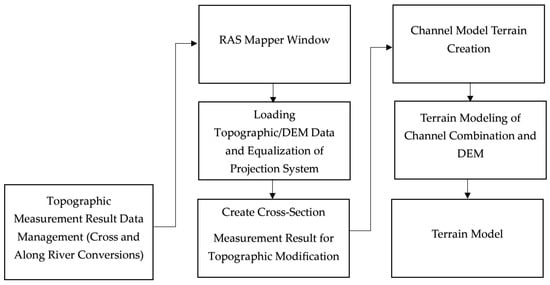
Figure 3.
The process of building terrain model components in the RAS Mapper tool.
The next component is geometry, which aims to provide an overview of the study area. The geometry component consists of 2D flow areas and boundary condition lines. The last component is the land cover layer, which is useful for knowing the level of roughness of a terrain, better known as the Manning coefficient. The Manning coefficient value refers to the Natural Resources Conservation Service (NRCS) in the HEC-RAS 2D modeling manual [48]. The process of preparing the 2D HEC-RAS simulation model in more detail can be seen in Figure 4 and Figure 5.
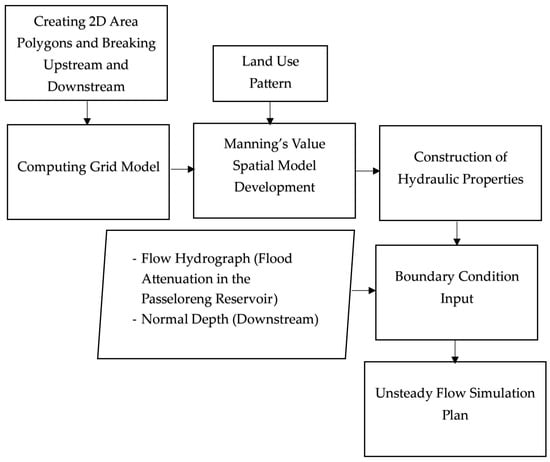
Figure 4.
The process of constructing geometry components and land cover layers in RAS Mapper.
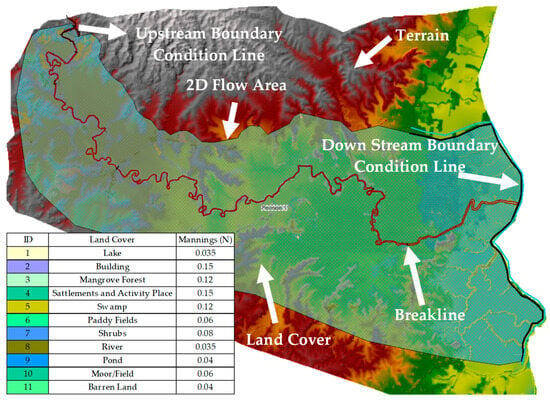
Figure 5.
Components of HEC-RAS 2D simulation model.
After the topographic data and planned flood discharge have been obtained, the data are input into the HEC-RAS application and then run. As a result of the run, we can see the flood phenomenon that occurs. However, before analyzing the further stages, the results of this 2D HEC-RAS numerical simulation analysis need to be verified with flood events that have occurred, to see the accuracy of the simulation results.
Verification is performed by analyzing the deviation between the simulated flood water level and the flood water level elevation in the field using the Mean Absolute Percentage Error (MAPE) approach. MAPE provides information on how much error there is between the model results and measured data in the field [49]. The equation used is
where At = field-measured data, Ft = simulation results data, and n = amount of data.
A MAPE value < 10% means the ability of the model is very good, 10–20% means the ability of the model is good, 20–50% means the ability of the model is feasible, and >50% that the ability of the model is poor [49].
2.3. Spatial Modeling of Flood-Prone Areas
The spatial modeling of flood-prone areas was prepared based on the results of flood depth simulations, with reference to the Head of the National Disaster Management Agency (BNPB) Regulation No. 2 of 2012, concerning general guidelines for disaster risk assessment. The level of flood-prone areas is classified into 3 classes, which can be seen in Table 1 [50].

Table 1.
Classification of flood-prone levels.
2.4. Flood Forecasting and Early Warning System
The next stage is to create a flood forecast and early warning system that may assist inhabitants in flood-prone areas in evacuating and moving their goods to a safe location, after the flood-tracing results have identified the areas that are exposed to flooding. The Directorate General of Water Resources’ Circular Letter no. 05/SE/D/2016, which contains guidelines for organizing river operation and maintenance activities, is cited in the preparation of this flood forecasting and early warning system. It states that there are three levels of flood hazard: level 1 (1.2–1.5 m before overflow occurs), level 2 (0.8–1.2 m before overflow occurs), and level 3 (<0.8 m before overflow occurs) [51]. An overview of the flood-monitoring points can be seen in Figure 6.

Figure 6.
Flood hazard level at monitoring points.
Based on the hydraulic analysis of the flood, the critical time from normal conditions to level 1, level 1 to level 2, and level 2 to level 3 is known. In addition to critical time, in flood forecasting and early warning systems, it is also necessary to analyze the travel time of floods from upstream monitoring points to downstream monitoring points, which aims to increase community preparedness downstream if they have received information from monitoring points upstream. The final stage of this system is to map the flood evacuation route, to provide an overview of safe evacuation places for people in flood-prone areas in the event of a flood disaster.
3. Results
3.1. Flood Discharge Analysis
This flood discharge analysis refers to the average rainfall trend of the region for the last 10 years, to see if there is a significant increase that is an effect of climate change. The rainfall data used come from four stations that affect the Gilireng watershed, namely, Panreng Station, Tingaraposi Station, Lurae Station, and Gilireng Station. The trend of the last 10 years of regional average rainfall data can be seen in Figure 7.
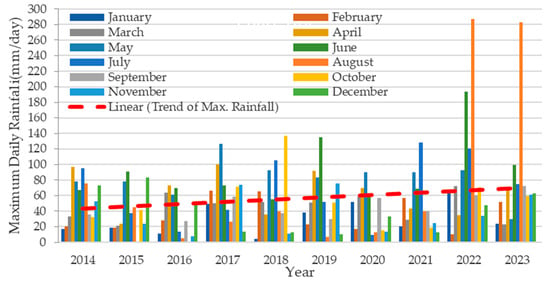
Figure 7.
Average rainfall trend of Gilireng watershed area.
Figure 7 shows that heavy rainfall (50–100 mm) occurred most frequently in the last 10 years. This is in line with the selected log-Pearson III method rainfall analysis which can be seen in Table 2.

Table 2.
Rainfall with various return periods.
Table 2 shows that heavy rainfall (50–100 mm) ranges from 1-year-return-period rainfall, meaning that heavy rainfall is likely to occur annually. Another thing that can be seen in Figure 7 is the linear trend of an increasing average daily maximum rainfall from year to year; even in the last 2 years, three periods of extreme rainfall (>150 mm/day) have occurred. When juxtaposed with Table 2, the extreme rainfall that occurred in the last 2 years is rainfall of the 25-year return period plan. So the process of converting rainfall into discharge uses 25-year-return-period rainfall, with an effective rainfall distribution for 6 h which can be seen in Figure 8.
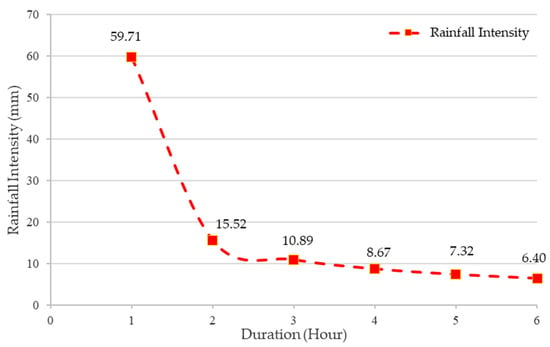
Figure 8.
Effective rainfall distribution of Gilireng watershed.
Furthermore, to convert rainfall into discharge, data on watershed morphometric characteristics are needed, which are analyzed using GIS technology and DEMNAS data. The results of the analysis of the watershed morphometric characteristics can be seen in Table 3.

Table 3.
Morphometric characteristics of Gilireng watershed.
Furthermore, data on watershed characteristics and effective rainfall are then inputted into the UH SUH equation model to determine the amount of flood discharge. In the upper part of the Gilireng watershed, there is the Passeloreng reservoir, which functions to supply irrigation water and raw water and reduce flood discharge. So, in the flood discharge analysis, it is necessary to analyze the attenuation of the Passeloreng reservoir flood discharge, by comparing the inflow and outflow discharges that pass through the dam spillway, which has a width of 77 m and an elevation of +50.50 m, to find out how much flood discharge can be attenuated by the Passeloreng reservoir. The results of the flood discharge analysis with a flood (Passeloreng reservoir) attenuation can be seen in Figure 9.
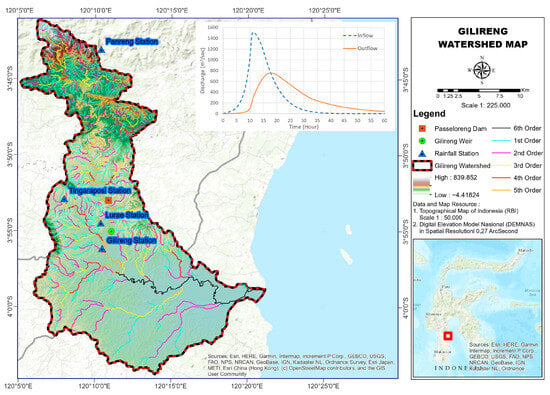
Figure 9.
Flood discharge analysis with flood (Passeloreng reservoir) attenuation.
3.2. Flood Hydraulic Tracing
In the flood hydraulic tracing process using HEC-RAS 2D simulation, flood hydrograph data, along with measurement data and DEMNAS, are used. The simulation of flood inundation in this study was carried out with the unsteady flow analysis and diffusion wave method, with a calculation interval of 1 s to obtain detailed results related to flood distribution due to the overflow of the Gilireng River. The results of the HEC-RAS 2D flood simulation can be seen in Figure 10.
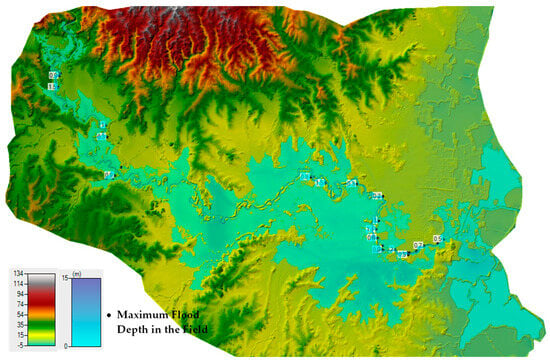
Figure 10.
Two-dimensional numerical simulation results of Gilireng River flooding.
Figure 10 shows that starting from the middle stream to the downstream, almost all parts of the river are overflowing. It is of concern that, even though the Passeloreng Dam has been built in the upstream section, the flood discharge flowing downstream still cannot be accommodated by the Gilireng River, so mitigation efforts are needed in order to reduce the risk of flood disasters.
Furthermore, Figure 10 is used as a reference in testing the accuracy of the simulation, by comparing the historical maximum flood in the field and the simulation results with the Mean Absolute Percentage Error (MAPE) approach. The verification results of historical floods and simulated floods can be seen in Table 4 and Figure 11.

Table 4.
Verification results of historical floods and simulated floods.
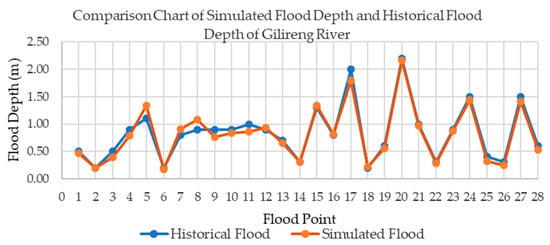
Figure 11.
Comparison of historical and simulated flood depths.
Table 4 shows that the error value between the simulated flood and the historical flood using the MAPE approach is 9.79%. Based on the interpretation of the MAPE value, the error value < 10% indicates that the simulation model’s ability is very good and can be continued in the next analysis. Figure 11 also directly shows the difference between the simulated flood and the historical flood.
3.3. Spatial Model of Flood-Prone Areas
After the 2D numerical simulation of the Gilireng River flood, the next step is to make a flood-prone map as a reference basis, to determine the extent of the flood impact caused by the Gilireng River overflow in the form of spatial data. In the spatial data, the flood hazard level is classified based on the depth class. Details of the areas affected by the Gilireng River overflow can be seen in Figure 12 and Figure 13.
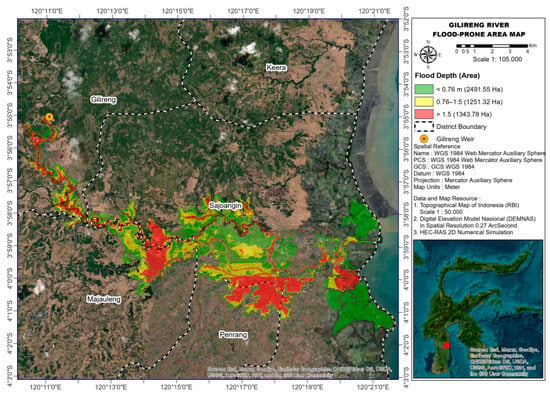
Figure 12.
Map of Gilireng River flood-prone areas.
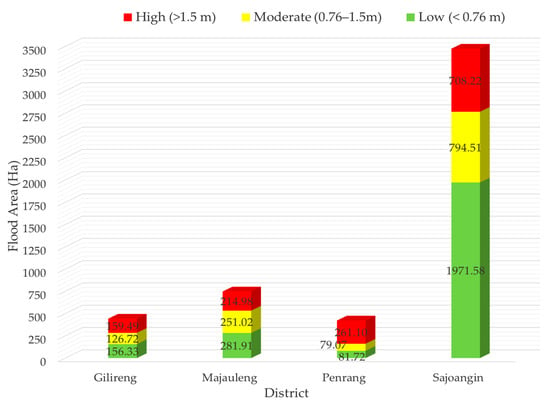
Figure 13.
The extent of the floodplain by district in the Gilireng watershed.
3.4. Flood Forecasting and Early Warning System
Establishing a flood forecasting and early warning system will help people living in flood-prone areas to anticipate floods and make preparations before a flood disaster occurs, by using flood information gathered from monitoring points. This is one of the initiatives being made to lessen the impact of floods caused by the Gilireng River overflow. The scheme of the flood forecasting and early warning system for the Gilireng watershed can be seen in Figure 14.
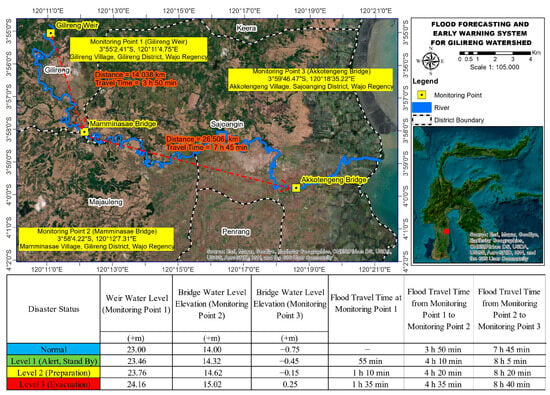
Figure 14.
Flood forecasting and early warning system for Gilireng watershed.
Furthermore, one of the important pieces of information that needs to be conveyed to the community is a flood evacuation map, which serves to facilitate people affected by flood disasters to immediately evacuate to the nearest area according to their place of residence. This can make it easier for the community to immediately secure their property and other valuables at the location provided and also make it easier for the government to provide immediate assistance such as food, clothing, medicine, and so on. Evacuation points are established based on areas that are safe from flood threats, with a travel time of less than 60 min, and that have the capacity to accommodate the nearest community affected by flooding. Evacuation routes to avoid flooding can be seen in Figure 15.
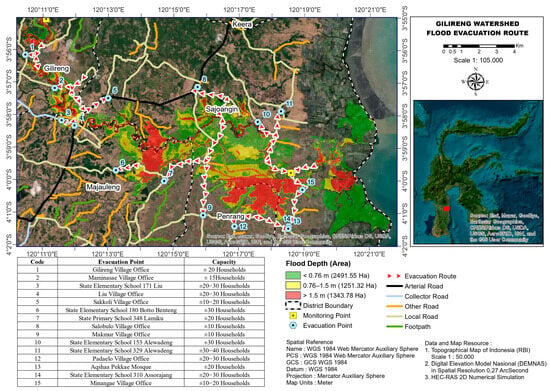
Figure 15.
Flood evacuation route map of Gilireng watershed.
4. Discussion
Data on rainfall trends in the Gilireng watershed show that the last 2 years have seen consecutive extreme rainfalls equivalent to 25-year-return-period rainfall, one of the effects of climate change. The hydrological analysis results in Figure 9 show that the peak inflow flood discharge or flood discharge from the UH SUH analysis is 1511.31 m3/s. After the dam spillway flood attenuation analysis, the peak outflow flood discharge becomes 754.48 m3/s, meaning that 756.83 m3/s or 50.08% of the peak flood discharge is reduced by the Passeloreng reservoir. This dam spillway outflow flood discharge is then used in the hydraulic flood impact analysis.
Although the Passeloreng Dam has been built upstream, the discharge of floodwater flowing downstream still cannot be accommodated by the Gilireng River, as shown in Figure 10. Furthermore, Figure 12 and Figure 13 show that the dominant land use affected by flooding due to the overflow of the Gilireng River is rice fields, and based on administrative boundaries there are four affected districts: Gilireng District covering 442.54 hectares; Majauleng District covering 747.90 hectares; Penrang District, covering 421.89 hectares; and Sajoangin District, covering 3474.31 hectares. These four districts are included in the Wajo Regency, which is in the lowlands, and the majority of the population still lives near the river or river border area, so the most suitable mitigation efforts are needed, in the form of a flood warning and early warning system, in order to reduce the risk of flood disasters in the Gilireng watershed.
Determining the flood travel time and three key moments at each cross-section of the monitoring site is the fundamental idea behind the development of the flood forecasting and early warning system. However, in order to facilitate the estimation of floods, real-time rainfall data should be used before the observation of travel time and water level. It is recognized that there is a risk of a flood disaster if the rain intensity is greater than 59.71 mm/hour, based on the findings of the hydrology section’s examination of rain intensity.
Figure 14 shows that three monitoring points support the flood forecasting and early warning system in the Gilireng watershed, namely, Gilireng Weir (MP.1), Mamminasae Bridge (MP.2), and Akkotengeng Bridge (MP.3). The flood travel time from MP.1 to MP.2 is 3 h 50 min, and from MP.2 to MP.3, it is 7 h 45 min. This travel time aims to enable downstream communities to respond quickly and accurately after receiving information from upstream communities. A fast and accurate response is necessary, due to critical conditions and very limited mitigation time.
Next is the forecasting of critical times at the monitoring points. There are three levels: level 1 (Alert, Stand By), which is a high probability of flooding, so that people are expected to continue to monitor information from monitoring point observers; level 2 (Preparation), namely, flooding cannot be avoided in some time (10 min to 1 h), so that people living in flood-prone areas are prepared; and level 3 (Evacuation), namely, the flood is coming any time; at this time, the community is expected to immediately evacuate, by bringing valuables to a place safe from flood disasters. The time required from normal conditions to level 3 at MP.1 is 1 h and 35 min, MP.2 is 45 min, and MP.3 is 55 min.
Based on the results of the analysis of flood time travel and critical time at the monitoring point, the total time required from the upstream monitoring point to level 3 at MP.1 is 1 h 35 min, MP.2 is 4 h 35 min, and MP.3 is 8 h 40 min. This is enough time for people living in flood-prone areas to evacuate to safer places.
There are 15 recommendations for the nearest flood evacuation points that are safe from flood disasters, which can be seen in Figure 10. The 15 recommended flood evacuation points spread across the Gilireng watershed consist of elementary schools, village offices, and mosques, with capacities ranging from 10 to 40 households.
The integration of UH SUH, HEC-RAS, and GIS used in this study is ideal for use in the development of flood forecasting and early warning systems. This can help stakeholders in making flood mitigation policies and provide new insights into the integration of several models. The results of the hydraulic analysis, with the UH SUH model integrated with the HEC-RAS hydraulic model, have an error of 9.79%, which shows that the integration of these two models is very good for interpreting events in the field. Furthermore, the results of the numerical model are modeled spatially, in order to provide information for people living in flood-prone areas. However, it should be noted that the main limitation of this research is the availability of digital elevation model (DEM) data with a high resolution in the HEC-RAS numerical modeling. Topographic data in the form of the National Digital Elevation Model (DEMNAS) with a resolution of 8.4 m cannot clearly depict the river cross-section. So, in this research, to overcome these obstacles, digital elevation model data are combined again with river topo-bathymetric measurement data to increase the level of modeling accuracy. Simulations like this also need very necessary verification data, be it of historical floods or from measuring devices in the field, to see whether the simulation can be used or still needs to be calibrated.
5. Conclusions
Based on the results of the research conducted, it is observed that the trend of rainfall patterns in the last 2 years in the Gilireng watershed is in the category of extreme rainfall (>150 mm/day), which corresponds to the rainfall of the 25-year return period. In converting rainfall into discharge, the UH SUH method obtained a 25-year-return-period flood discharge of 1511.31 m3/s After analyzing the dam spillway flooding, the peak outflow flood discharge became 754.48 m3/s, meaning that 756.83 m3/s or 50.08% of the peak flood discharge was reduced by the Passeloreng reservoir. The flood discharge that has been reduced by the Passeloreng reservoir still cannot be accommodated by the Gilireng River. There are four districts affected, namely, Gilireng District (442.54 Ha), Majauleng District (747.90 Ha), Penrang District (421.89 Ha), and Sajoangin District (3474.31 Ha). These districts are included in the Wajo Regency which is in the lowlands, and the majority of the population still lives near the river or river border area, so that mitigation efforts are needed in the form of preparing a flood forecasting and early warning system. Based on the analysis of flood time travel and critical time at monitoring points for the preparation of flood forecasting and early warning systems, it is ascertained that the total time required from the upstream observation point to level 3 at MP.1 (Gilireng Dam) is 1 h 35 min, MP.2 (Mamminasae Bridge) is 4 h 35 min, and MP.3 (Akkotengeng Bridge) is 8 h 40 min. This time is very sufficient for people living in flood-prone areas to evacuate to the 15 recommended evacuation sites.
Based on the results of this study, it also shows that the integration of UH SUH, HEC-RAS, and GIS used in this study is ideal for use in the preparation of flood forecasting and early warning systems with error values <10%. The main limitation in this numerical modeling is the availability of high-resolution digital elevation model (DEM) data to support the simulation accuracy. Despite these limitations, a model like this can be applied anywhere, provided that there are historical flood data in the field to see the accuracy of the simulation before proceeding to the next analysis.
In the future, taking into account technological advances, what needs to be done to improve the simulation accuracy is to use topographic data derived from Light Detection and Ranging (LIDAR) technology. If lidar technology has not yet been implemented, it can be dealt with by using drones, in combination with river land measurement/bathymetry with the same reference tie points.
By looking at the existing research results, we recommend integrating UH SUH, HEC-RAS, and GIS in the preparation of flood forecasting and early warning systems, provided that there are historical flood data in the field to test the accuracy of the simulation.
Author Contributions
Conceptualized the study, performed data analysis, and wrote the manuscript, M.R.M.; review, editing, and supervision, F.M., R.T.L. and R.K. All authors have read and agreed to the published version of the manuscript.
Funding
This research received no external funding.
Data Availability Statement
All data are included in the submitted article.
Acknowledgments
The authors would like to thank the Hydraulics Laboratory of Hasanuddin University, State Polytechnic of Ujung Pandang, Aria Jasa Konsultan, and the anonymous reviewers for their constructive suggestions.
Conflicts of Interest
The authors declare no conflicts of interest.
References
- Fulazzaky, M. Challenges of Integrated Water Resources Management in Indonesia. Water 2014, 6, 2000–2020. [Google Scholar] [CrossRef]
- Asdak, C.; Yulizar; Subiyanto. A National Policy On Indonesia’s Integrated Water Resource Conservation Management. Indones. J. For. Res. 2023, 10, 151–162. [Google Scholar] [CrossRef]
- Ward, P.J.; de Ruiter, M.C.; Mård, J.; Schröter, K.; Van Loon, A.; Veldkamp, T.; von Uexkull, N.; Wanders, N.; AghaKouchak, A.; Arnbjerg-Nielsen, K.; et al. The Need to Integrate Flood and Drought Disaster Risk Reduction Strategies. Water Secur. 2020, 11, 100070. [Google Scholar] [CrossRef]
- Islam, R.; Kamaruddin, R.; Ahmad, S.A.; Jan, S.J.; Anuar, A.R. A Review on Mechanism of Flood Disaster Management in Asia. Int. Rev. Manag. Mark. 2016, 6, 29–52. [Google Scholar]
- Chai, J.; Wu, H.-Z. Prevention/Mitigation of Natural Disasters in Urban Areas. Smart Constr. Sustain. Cities 2023, 1, 4. [Google Scholar] [CrossRef]
- Yang, T.-H.; Liu, W.-C. A General Overview of the Risk-Reduction Strategies for Floods and Droughts. Sustainability 2020, 12, 2687. [Google Scholar] [CrossRef]
- Ramadhan, C.; Dina, R.; Nurjani, E. Spatial and Temporal Based Deforestation Proclivity Analysis on Flood Events With Applying Watershed Scale (Case Study: Lasolo Watershed in Southeast Sulawesi, Central Sulawesi, and South Sulawesi, Indonesia). Int. J. Disaster Risk Reduct. 2023, 93, 103745. [Google Scholar] [CrossRef]
- Mahmud, M.; Kusumandari, A.; Sudarmadji, S.; Supriyatno, N. A Study of Flood Causal Priority in Arui Watershed, Manokwari Regency, Indonesia. J. Manaj. Hutan Trop. 2018, 24, 81–94. [Google Scholar] [CrossRef]
- Mazalena, R.D.; Ahmad; Yusup, Y. Analysis of Run-off Potential for Flash Flood Management in Rahakolowu Watershed. IOP Conf. Ser. Earth Environ. Sci. 2022, 986, 012046. [Google Scholar] [CrossRef]
- Siregar, R.I.; Nursyamsi, N.; Indrawan, I. An Approach of Travel Time of Flood Peaks and Runoff Model towards Low Impact Development. Simetrikal J. Eng. Technol. 2020, 2, 1–12. [Google Scholar] [CrossRef]
- Kuller, M.; Schoenholzer, K.; Lienert, J. Creating Effective Flood Warnings: A Framework From a Critical Review. J. Hydrol. 2021, 602, 126708. [Google Scholar] [CrossRef]
- Lee, J.H.; Yuk, G.M.; Moon, H.T.; Moon, Y.-I. Integrated Flood Forecasting and Warning System against Flash Rainfall in the Small-Scaled Urban Stream. Atmosphere 2020, 11, 971. [Google Scholar] [CrossRef]
- Cole, S.J.; Moore, R.J.; Wells, S.C.; Mattingley, P.S. Real-Time Forecasts of Flood Hazard and Impact: Some UK Experiences. E3S Web Conf. 2016, 7, 18015. [Google Scholar] [CrossRef]
- Silvestro, F.; Rossi, L.; Campo, L.; Parodi, A.; Fiori, E.; Rudari, R.; Ferraris, L. Impact-Based Flash-Flood Forecasting System: Sensitivity to High Resolution Numerical Weather Prediction Systems and Soil Moisture. J. Hydrol. 2019, 572, 388–402. [Google Scholar] [CrossRef]
- Schroeder, A.J.; Gourley, J.J.; Hardy, J.; Henderson, J.J.; Parhi, P.; Rahmani, V.; Reed, K.A.; Schumacher, R.S.; Smith, B.K.; Taraldsen, M.J. The Development of a Flash Flood Severity Index. J. Hydrol. 2016, 541, 523–532. [Google Scholar] [CrossRef]
- Rosmadi, H.S.; Ahmed, M.F.; Bin Mokhtar, M.; Lim, C.K. Reviewing Challenges of Flood Risk Management in Malaysia. Water 2023, 15, 2390. [Google Scholar] [CrossRef]
- Syed Musa, S.M.S.; Md Noorani, M.S.; Abdul Razak, F.; Ismail, M.; Alias, M.A.; Hussain, S.I. An Early Warning System for Flood Detection Using Critical Slowing Down. Int. J. Environ. Res. Public Health 2020, 17, 6131. [Google Scholar] [CrossRef] [PubMed]
- Costabile, P.; Costanzo, C.; Kalogiros, J.; Bellos, V. Toward Street-Level Nowcasting of Flash Floods Impacts Based on HPC Hydrodynamic Modeling at the Watershed Scale and High-Resolution Weather Radar Data. Water Resour. Res. 2023, 59, e2023WR034599. [Google Scholar] [CrossRef]
- Kauffeldt, A.; Wetterhall, F.; Pappenberger, F.; Salamon, P.; Thielen, J. Technical Review of Large-Scale Hydrological Models For Implementation in Operational Flood Forecasting Schemes on Continental Level. Environ. Model. Softw. 2016, 75, 68–76. [Google Scholar] [CrossRef]
- Li, J.; Chen, Y.; Wang, H.; Qin, J.; Li, J.; Chiao, S. Extending Flood Forecasting Lead Time in a Large Watershed by Coupling WRF QPF With a Distributed Hydrological Model. Hydrol. Earth Syst. Sci. 2017, 21, 1279–1294. [Google Scholar] [CrossRef]
- Alqreai, F.N.; Altuwaijri, H.A. Hydrological Modeling and Evaluation of the Efficiency of Culverts in Drainage Basins Affecting the North Railway in Wadi Malham. Sustainability 2023, 15, 14489. [Google Scholar] [CrossRef]
- Sultan, D.; Tsunekawa, A.; Tsubo, M.; Haregeweyn, N.; Adgo, E.; Meshesha, D.T.; Fenta, A.A.; Ebabu, K.; Berihun, M.L.; Setargie, T.A. Evaluation of Lag Time and Time of Concentration Estimation Methods in Small Tropical Watersheds in Ethiopia. J. Hydrol. Reg. Stud. 2022, 40, 101025. [Google Scholar] [CrossRef]
- Mustamin, M.R. Synthetic Unit Hydrograph Modeling Based on Watershed Morphometry in South Sulawesi. Ph.D. Thesis, Hasanuddin University, Gowa, Indonesia, 2024. [Google Scholar]
- Ming, X.; Liang, Q.; Xia, X.; Li, D.; Fowler, H.J. Real-Time Flood Forecasting Based on a High-Performance 2-D Hydrodynamic Model and Numerical Weather Predictions. Water Resour. Res. 2020, 56, e2019WR025583. [Google Scholar] [CrossRef]
- Hou, J.; Han, H.; Li, Z.; Guo, K.; Qin, Y. Effects of Morphological Change On Fluvial Flood Patterns Evaluated By a Hydro-Geomorphological Model. J. Hydroinform. 2018, 20, 633–644. [Google Scholar] [CrossRef]
- Rak, G.; Kozelj, D.; Steinman, F. The Impact of Floodplain Land Use On Flood Wave Propagation. Nat. Hazards 2016, 83, 425–443. [Google Scholar] [CrossRef]
- Tsakiris, G. Flood Risk Assessment: Concepts, Modelling, Applications. Nat. Hazards Earth Syst. Sci. 2014, 14, 1361–1369. [Google Scholar] [CrossRef]
- Peker, İ.B.; Gülbaz, S.; Demir, V.; Orhan, O.; Beden, N. Integration of HEC-RAS and HEC-HMS with GIS in Flood Modeling and Flood Hazard Mapping. Sustainability 2024, 16, 1226. [Google Scholar] [CrossRef]
- Ezz, H. Integrating GIS and HEC-RAS to Model Assiut Plateau Runoff. Egypt. J. Remote Sens. Sp. Sci. 2018, 21, 219–227. [Google Scholar] [CrossRef]
- Yerramilli, S. A Hybrid Approach of Integrating HEC-RAS and GIS Towards the Identification and Assessment of Flood Risk Vulnerability in the City of Jackson, MS. Am. J. Geogr. Inf. Syst. 2012, 1, 7–16. [Google Scholar] [CrossRef]
- Azimah, M.N.; Adib, M.R.M.; Mustaffa, A.A. Integration of Hydraulic Model (HEC-RAS) With Geographical Information System (GIS) in Developing Flood Evacuation Center Along Sembrong River. IOP Conf. Ser. Earth Environ. Sci. 2019, 220, 012057. [Google Scholar] [CrossRef]
- Khaghan, A.; Mojaradi, B. The Integrate of HEC-HMS and HEC-RAS Models in GIS Integration Models to Simulate Flood (Case Study: The Area of Karaj). Curr. World Environ. 2016, 11, 1–5. [Google Scholar] [CrossRef][Green Version]
- Azouagh, A.; El Bardai, R.; Hilal, I.; Stitou el Messari, J. Integration of GIS and HEC-RAS in Floods Modeling of Martil River (Northern Morocco). Eur. Sci. J. ESJ 2018, 14, 130–142. [Google Scholar] [CrossRef]
- Sarsito, D.A.; Bramanto, B. Digital Elevation Model Alternatives Assessment for Deformation Analysis Purposes Using GNSS and INSAR. J. Meteorol. Dan Geofis. 2022, 23, 29–37. [Google Scholar] [CrossRef]
- Ziadat, F.M.; Taimeh, A.Y. Effect of Rainfall Intensity, Slope, Land Use and Antecedent Soil Moisture on Soil Erosion in an Arid Environment. Land Degrad. Dev. 2013, 24, 582–590. [Google Scholar] [CrossRef]
- Mustamin, M.R.; Maricar, F.; Karamma, R. Hydrological Analysis In Selecting Flood Discharge Method In Watershed Of Kelara River. INTEK J. Penelit. 2021, 8, 141–150. [Google Scholar] [CrossRef]
- Ruhiat, Y. Forecasting Rainfall and Potential for Repeated Events to Predict Flood Areas in Banten Province, Indonesia. J. Meas. Eng. 2022, 10, 68–80. [Google Scholar] [CrossRef]
- Faradiba. Analysis of Intensity, Duration, and Frequency Rain Daily of Java Island Using Mononobe Method. J. Phys. Conf. Ser. 2021, 1783, 012107. [Google Scholar] [CrossRef]
- Kusumastuti, C.; Sudjarwo, P.; Christhie, M.; Krisna, T. Intensity-Duration-Frequency (IDF) Curve and the Most Suitable Method to Determine Flood Peak Discharge in Upper Werba Sub-Watershed. Civ. Eng. Dimens. 2019, 21, 70–75. [Google Scholar] [CrossRef]
- Singh, P.K.; Mishra, S.K.; Jain, M.K. A Review of The Synthetic Unit Hydrograph: From The Empirical UH to Advanced Geomorphological Methods. Hydrol. Sci. J. 2014, 59, 239–261. [Google Scholar] [CrossRef]
- Tunas, I.G.; Anwar, N.; Lasminto, U. A Synthetic Unit Hydrograph Model Based on Fractal Characteristics of Watersheds. Int. J. River Basin Manag. 2019, 17, 465–477. [Google Scholar] [CrossRef]
- Zulfa, G.F.; Purnaditya, N.P.; Wigati, R.; Subekti, S.; Priyambodho, B.A. Prediction of Snyder Synthetic Unit Hydrograph Coefficient for Cidurian Watershed. Fondasi J. Tek. Sipil 2023, 12, 271–281. [Google Scholar] [CrossRef]
- Tunas, I.G.; Anwar, N.; Lasminto, U. Fractal Characteristic Analysis of Watershed as Variable of Synthetic Unit Hydrograph Model. Open Civ. Eng. J. 2016, 10, 706–718. [Google Scholar] [CrossRef]
- Tunas, I.G. The Application of ITS-2 Model for Flood Hydrograph Simulation in Large-Size Rainforest Watershed, Indonesia. J. Ecol. Eng. 2019, 20, 112–125. [Google Scholar] [CrossRef] [PubMed]
- Ozbey, N.; Gül, U.S. Constructing Uncertainty Budget for A Two-Dimensional Hydraulic Model. IOP Conf. Ser. Mater. Sci. Eng. 2019, 615, 012059. [Google Scholar] [CrossRef]
- Amaliah, R.; Ginting, B.M. Investigating the Capability of HEC-RAS Model for Tsunami Simulation. J. Civ. Eng. Forum 2023, 9, 161–180. [Google Scholar] [CrossRef]
- Bagheri, K.; Requieron, W.; Tavakol, H. A Comparative Study of 2-Dimensional Hydraulic Modeling Software, Case Study: Sorrento Valley, San Diego, California. J. Water Manag. Model. 2020, 28, C471. [Google Scholar] [CrossRef]
- Brunner, G.W. HEC-RAS, River Analysis System 2D Modeling User’s Manual Version 5.0; Hydrologic Engineering Center, Institute for Water Resources, US Army Corps of Engineers: Davis, CA, USA, 2016.
- Khair, U.; Fahmi, H.; Al Hakim, S.; Rahim, R. Forecasting Error Calculation with Mean Absolute Deviation and Mean Absolute Percentage Error. J. Phys. Conf. Ser. 2017, 930, 012002. [Google Scholar] [CrossRef]
- Amri, M.R.; Yulianti, G.; Yunus, R.; Wiguna, S.; Adi, A.W.; Ichwana, A.N.; Randongkir, R.E.; Septian, R.T. Risiko Bencana Indonesia (Indonesian Disaster Risk), 1st ed.; Jati, R., Amri, M.R., Eds.; Badan Nasional Penanggulangan Bencana: Jakarta, Indonesia, 2016.
- Maricar, F.; Karamma, R.; Mustamin, M.R.; Maricar, M.F. Numerical Simulation of Flood Propagation in the Kelara River Flood Early Warning System. J. Water Manag. Model. 2023, 31, C501. [Google Scholar] [CrossRef]
Disclaimer/Publisher’s Note: The statements, opinions and data contained in all publications are solely those of the individual author(s) and contributor(s) and not of MDPI and/or the editor(s). MDPI and/or the editor(s) disclaim responsibility for any injury to people or property resulting from any ideas, methods, instructions or products referred to in the content. |
© 2024 by the authors. Licensee MDPI, Basel, Switzerland. This article is an open access article distributed under the terms and conditions of the Creative Commons Attribution (CC BY) license (https://creativecommons.org/licenses/by/4.0/).